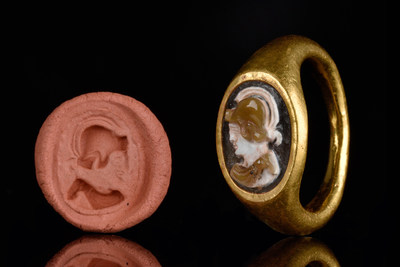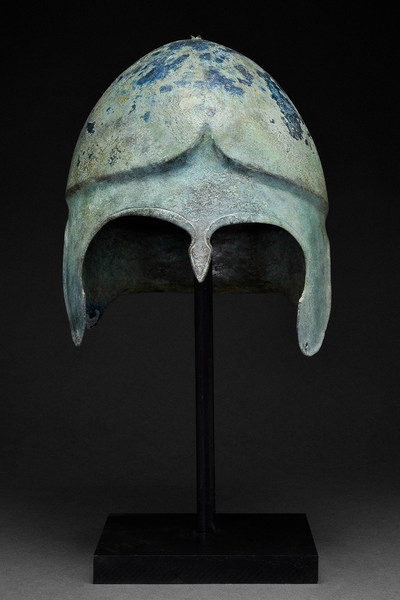LONDON, Jan. 10, 2022 /PRNewswire/ — Apollo Galleries, London’s premier source for authentic, fully vetted ancient art and antiquities, will host its first auction of the New Year on Sunday, January 16, with absentee and Internet live bidding through LiveAuctioneers. The breathtaking assemblage of rarities from legendary civilizations is offered with authoritative descriptions and assessments from a newly-engaged team of specialists whose experience at the highest echelons of the art trade is amply documented.
The auction opens with a stunning selection of ancient ceramics, glass and metalware that includes many unusual items, such as a colorful Egyptian faience-beaded mummy shroud and mask, and silver letters used to spell out a good-luck message on Roman soldiers’ belts. Leading the group is a rare and important Neo-Assyrian vessel, circa 800-600 BC, which was cut and hollowed out from a single large piece of solid rock crystal – a feat that would have required considerable skill. Few examples of its type are known. Its lineage can be traced back to the 1960s and it is similar to a work that sold in 2012 at Christie’s London. Accompanied by a CIRAM lab authentication test and its original 1990s scientific report from Professor W.G. Lambert, it is estimated at £40,000-£80,000.
Another stellar piece is a circa 550-500BC blackware bucchero kantharos from Etruria. Distinctly burnished, bucchero is considered the signature ceramic of the Etruscans and was mostly used by the elite class. The bucchero offered by Apollo Galleries has been held in several prestigious European collections and was also sold by Christie’s London, in 1998. It comes to auction with a £10,000-£20,000 estimate.
Designed to hold wine, a handsome Etruscan-Corinthian pottery olpe vessel with incised decoration on its ovoid body comes from a private collector who acquired it directly from the University of Pennsylvania Museum of Archaeology in 1965. Estimate: £6,000-£9,000
Wearable ancient jewelry of extraordinary beauty includes rings, pendants, amulets, earrings, necklaces and bracelets, many of them crafted of gold and adorned with precious or semiprecious stones. A circa 300-400AD Roman sardonyx cameo pendant features the carved head of Medusa is estimated at £6,000-£9,000. A fabulous Roman gold ring with a sardonyx cameo of Mars dates to the Julio-Claudian Period, circa 100AD. It is sculpted in four layers, with an articulated eye and a crested helmet ornamented in relief. Estimate: £6,000-£9,000
Arms and armor always play a commanding role at Apollo Galleries’ auctions, with helmets consistently ranking amongst the most sought-after items. The January 16 sale includes several exceptional examples: a circa 550-450BC Greek Chalcidian bronze helmet of a type that was still in use by hoplite soldiers in the time of Alexander the Great, £45,000-£85,000; and an impressive and well-preserved medieval iron helmet with ventilation holes and a shaped nose-guard, £15,000-£30,000.
Premium-quality Asian antiquities include a circa 200-300AD grey schist Gandharan upper torso of Bodhisattva that is similar to an example sold at Sotheby’s in 2007. Estimate £40,000-£80,000. Another standout, a Late Shang Dynasty (circa 1300-1200BC) jia, or ritual wine vessel, is offered with a £20,000-£40,000 estimate.
Apollo Galleries ships worldwide. All packing is handled by white-glove specialists in-house. Questions: call +44 7424 994167; email
327227@email4pr.com
. Visit www.apollogalleries.com
Apollo Galleries is a member of the British Numismatic Trading Association (BNTA) and the Art Loss Register (AR).
Rate of conversion (approx.): £1 = US$1.35
Media Contact:
Dr. Ivan Bonchev +44 7424 994167
327227@email4pr.com
SOURCE Apollo Galleries



